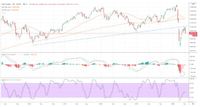European Stock Market Overview

European shares as reflected by the DAX have experienced a wild ride in March and April. The German index tumbled 40% from peak to trough and then rebounded 33% during April and early May. Strong European stimulus led to a robust rally, but Europe will likely need more from its leaders to get through the self-imposed lockdown that led to a massive recession. Fiscal stimulus in addition to strong quantitative easing from the ECB is the recipe needed to get Europe back on track.
EU Ministers Agree to Fiscal Stimulus
In April after very robust negotiations, EU ministers agreed to three programs that had a combined worth of worth 540 billion euros. While the amount of fiscal stimulus is massive, it pales in comparison to the first US stimulus of 2.3 trillion. It appears the fiscally conservative northern European nations have been unwilling to accept the demand for “corona bonds” which would allow Europe to raise money using combined debt instruments from the 19-nations in the EU. While the issuance of bonds continues to elude EU ministers, authorities did bridge their differences over the 240 billion euro credit line, provided by the European Stability Mechanism.
European Commission is getting ready to roll out a new economic plan which will focus on a recovery instrument that will co-exist with the bloc’s budget and directed towards public investments. Separately Italy approved it’s €55 billion stimulus package. The money will go to the unemployed, furloughed workers, and self-employed, tax cuts, and funding for struggling companies.
The biggest issue for the EU during this crisis is who will pay for the stimulus. The leaders in the north do not want to bail out the countries in the south that were in financial difficulty before the pandemic hit. Trying to segregate the difference between what is needed now due to the spread of the coronavirus, and what had occurred ahead of the pandemic is very difficult and causing consternation.
What is Going on in the UK
Across the channel, the UK is continuing to focus on both fiscal and monetary policy. The Bank of England’s Governor Bailey hinted that the GBP200 billion bond purchase program will likely be extended as early as next month. At the last monetary policy meeting, the majority wanted to wait to extend the QE program while two members dissented in favor of an immediate increase of GBP100 billion in Gilt purchases.
Volatility Has Eased After Surging
The choppy price action on the DAX has been driven by extremely elevated levels of implied volatility. Implied volatility is a key input used by trader’s to price options. Implied volatility measures how much options traders believe the underlying price of an asset will move over the next 12-months. Implied volatility on the DAX surged to 80% in March, the highest seen since the great recession in 2008/2009. Implied volatility on the DAX has eased back to 40%, but this remains nearly 3-times as high as volatility was in mid-February.
The DAX tumbled in March and then rebounded sharply in April only to run into resistance near the breakdown level which is signified by an upward sloping trend line that comes in near 11,000. Stock trading momentum is neutral as the fast stochastic generates a crossover sell signal in the middle of the neutral range with a flat trajectory. Medium-term momentum is also flat as the MACD (moving average convergence divergence) histogram prints in the red with a flat trajectory reflecting consolidation.

